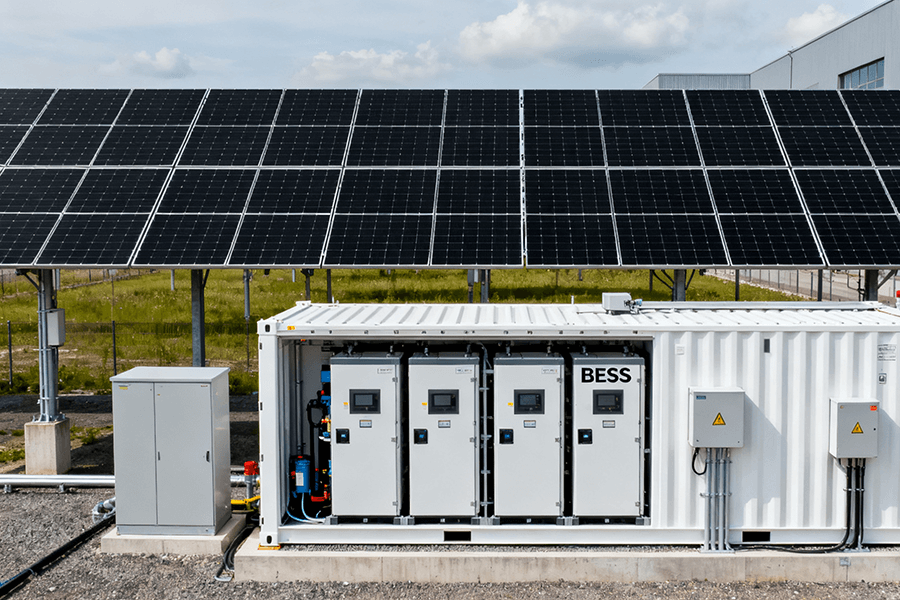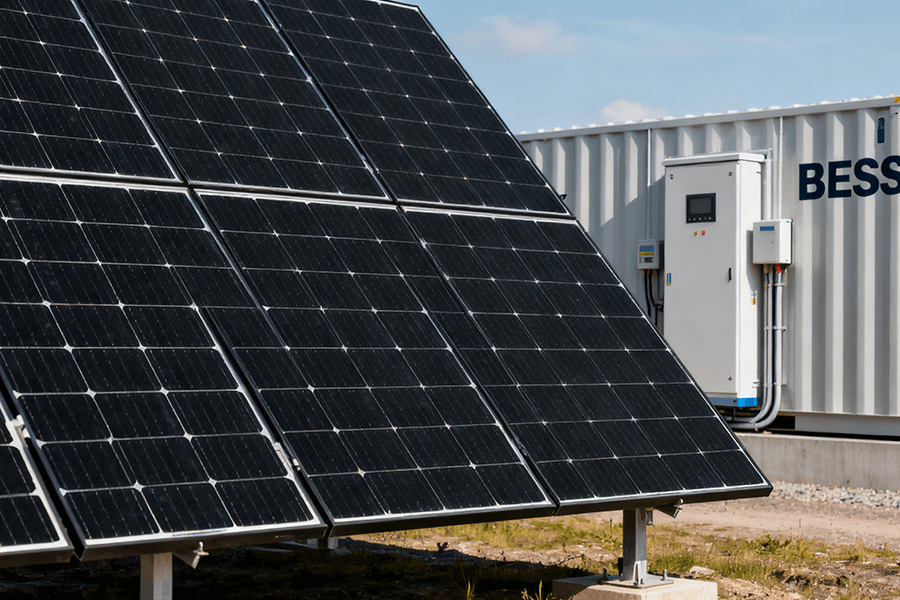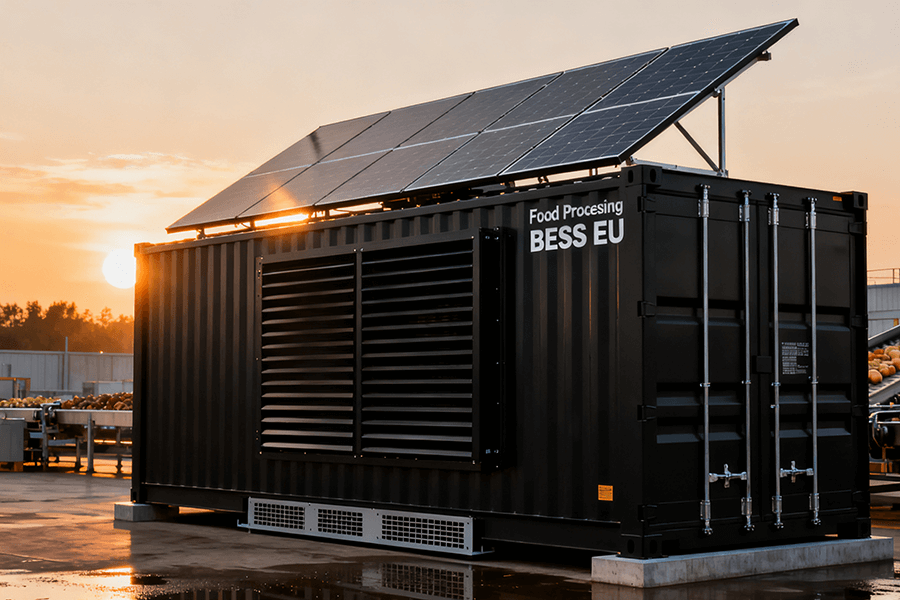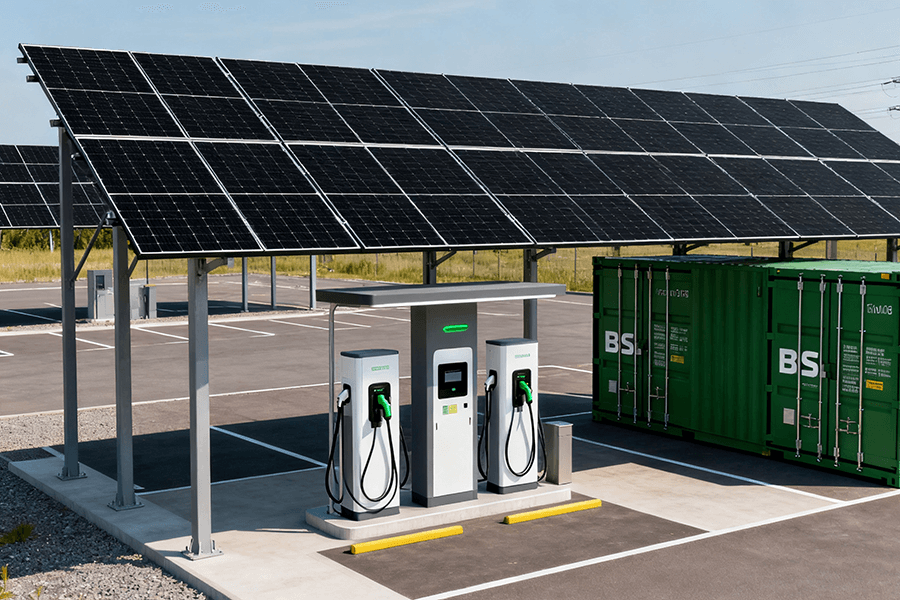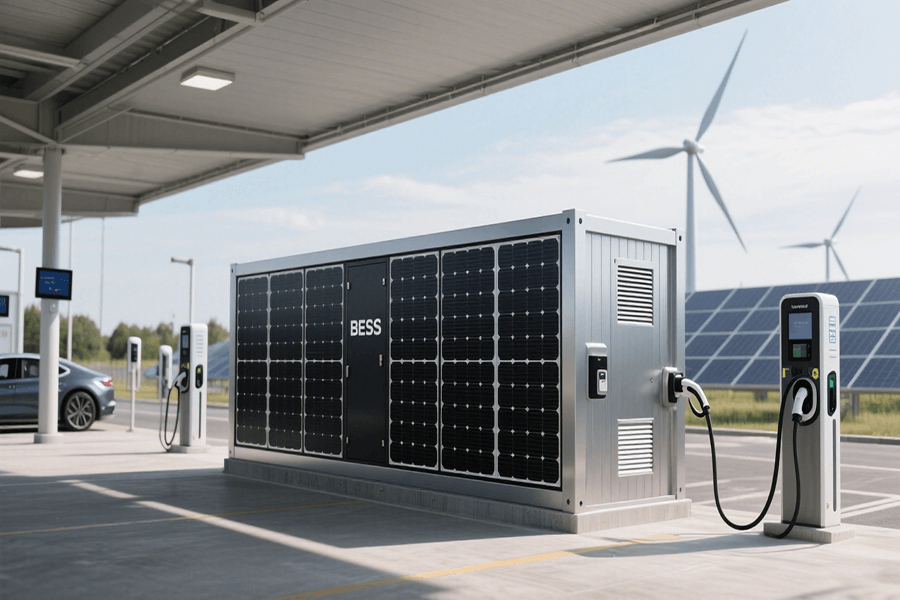
Introduction
Hey there, energy enthusiasts! 🌟 The European Union has thrown down the gauntlet with its ambitious plan: 100% renewable-powered EV charging by 2030. This isn’t just a pie-in-the-sky idea; it’s a legally binding target that’s set to reshape how we power our vehicles across the continent.
It’s like a high-stakes energy race, and Battery Energy Storage System (BESS) Containers are emerging as the unlikely heroes. Solar-powered charging stations are all the rage, but they come with a catch: the sun doesn’t shine 24/7, and when everyone decides to charge their EVs at once—say, after work hours—it can put a real strain on the grid.
Enter BESS Containers! 🚀 These nifty units are like the cool kids on the block, helping to balance the load. In fact, they can reduce grid peak loads by a whopping 60% (source: Eurelectric’s 2024 Smart Grids Report). This is not only great for keeping the grid from throwing a tantrum but also for ensuring a smooth and sustainable charging experience for all those shiny new EVs hitting EU roads.
By 2030, the EU expects over 30 million EVs to be on the roads, and without BESS, meeting their charging needs with renewables would be like trying to fill a bucket with a sieve.
Why BESS Containers Matter for Renewable Charging
The EU’s 2030 renewable charging mandate isn’t just a lofty goal—it’s a strategic necessity driven by the rapid electrification of transportation. According to the latest ACEA statistics, European electric vehicle sales surged by 35% year-over-year in 2024, signaling an exponential growth trajectory. This explosive adoption rate poses a significant challenge: relying solely on the existing grid, which still sources a substantial portion of its energy from fossil fuels, simply won’t meet future demand.
The current electrical grid infrastructure was not designed to handle the synchronized charging of millions of electric vehicles, particularly during peak consumption periods. As illustrated in the table below, peak charging hours coincide with traditional evening electricity demand spikes, putting immense strain on the grid:
| Time of Day | Grid Load (Typical) | EV Charging Demand (Estimated) |
|---|---|---|
| Morning Rush | Moderate | Low |
| Midday | Low | Moderate |
| Evening Rush | High | Very High |
Solar and wind power offer a promising renewable solution, but their intermittent nature presents operational hurdles:
- Solar energy production ceases at night
- Wind turbines generate variable output depending on weather conditions
This inconsistency risks undermining the reliability of renewable energy sources, unless an effective storage mechanism is in place.
Enter BESS (Battery Energy Storage System) Containers—a game-changing technology designed to bridge this gap. These modular storage units operate on a simple yet revolutionary principle:
- Energy Capture: During periods of oversupply (e.g., sunny afternoons when electricity generation exceeds immediate demand), BESS Containers capture excess renewable energy.
- Smart Storage: The captured energy is stored within the containerized battery systems, ready for future use.
- Strategic Discharge: When evening rush hour hits and EV charging demand peaks, BESS Containers release stored energy, ensuring a consistent supply of clean electricity.
In essence, BESS Containers function as intelligent energy buffers, optimizing the utilization of renewable resources. By:
- Storing surplus power to prevent energy waste
- Releasing energy precisely when needed
These systems enhance grid resilience and support the EU’s ambitious 2030 sustainability targets. This technology represents a critical step towards building a more:
- Reliable
- Efficient
- Environmentally friendly electric vehicle charging ecosystem
Integration with Solar Canopies: A Match Made in Energy Heaven
How It Works
Envisioning a Futuristic Energy Ecosystem
Imagine a state-of-the-art energy ecosystem where sustainability and functionality converge seamlessly. At the core of this innovative setup is a 50–200 kW solar canopy—an engineering marvel that transcends the traditional role of a mere power generator.
Dual-Purpose Design
- Power Generation: Outfitted with high-efficiency photovoltaic (PV) panels, these canopies efficiently convert sunlight into electricity.
- Enhanced User Experience: Beyond power production, the canopies serve as shaded parking areas, protecting vehicles from the sun’s harsh rays. This not only keeps cars cooler on hot days but also helps mitigate the urban heat island effect, contributing to a more comfortable urban environment.
Overcoming the Challenge of Solar Intermittency
Despite its numerous benefits, solar power has one significant limitation: intermittency. When the sun sets or during peak EV charging periods—such as holidays, weekends, or after-work hours—the demand for electricity can quickly surpass the solar canopy’s generation capacity.
Introducing the BESS Container
This is where the Battery Energy Storage System (BESS) Container steps in as a game-changing solution for optimizing energy management.
Technical Specifications
- Advanced Lithium-Ion Batteries: The BESS Container is equipped with cutting-edge lithium-ion batteries renowned for their high energy density and long lifespan.
- Intelligent Control Systems: These sophisticated systems monitor and manage the flow of energy, ensuring optimal performance.
How It Works
- Energy Storage: During the day, when solar production is at its peak, the BESS Container stores excess energy generated by the solar canopy.
- Demand Response: As EV charging demand fluctuates, the system automatically discharges stored energy, providing a consistent and reliable power supply to EV chargers.
- Microgrid Creation: This seamless integration of solar generation, energy storage, and EV charging creates a localized microgrid. By reducing reliance on the main electrical grid, the system maximizes the use of renewable energy, contributing to a more sustainable energy future.
Real-World Impact: A German Case Study
To understand the practical effectiveness of this system, let’s consider a real-world example from Germany. According to data from the German Solar Association:
- Solar Canopy Output: A 100 kW solar canopy in a typical German climate can generate approximately 100,000 kWh of electricity annually.
- Energy Utilization: By integrating a BESS Container with the appropriate capacity, nearly all of this renewable energy can be harnessed for on-site EV charging. This not only significantly reduces carbon emissions but also optimizes the economic value of the generated power by avoiding selling energy back to the grid at lower feed-in tariffs.
The Cost Savings
The “solar + storage” combination offers compelling financial advantages in addition to environmental benefits. Charging an electric vehicle with this integrated system costs as little as €0.25/kWh, significantly lower than the average grid electricity price of €0.40/kWh, as reported by Eurostat 2025 Energy Prices.
Let’s examine the financial impact for a busy EV charging hub that serves 100 vehicles daily, with each vehicle consuming an average of 30 kWh:
| Charging Method | Cost per kWh | Daily Cost | Annual Cost | Annual Savings |
|---|---|---|---|---|
| Solar + BESS | €0.25 | €750 | €273,750 | €136,875 |
| Grid Electricity | €0.40 | €1,200 | €438,000 | €0 |
These savings are not only significant but also compound over time. Moreover, they contribute to the long-term financial viability of charging infrastructure, making EV charging more accessible and affordable for consumers. Additionally, by reducing grid dependency, the system helps mitigate the impact of future electricity price increases, providing a stable and predictable cost structure for charging operators.
V2G Capabilities: Turning EVs into Energy Suppliers
What Is V2G?
The Revolutionary Convergence of BESS Containers and V2G Technology
The integration of Battery Energy Storage System (BESS) containers with Vehicle-to-Grid (V2G) capabilities marks a transformative milestone in the energy sector. V2G technology isn’t just an incremental improvement—it’s a paradigm shift that redefines the role of electric vehicles (EVs) from passive energy consumers to active contributors within the power grid ecosystem.
Unlike traditional unidirectional charging systems, V2G technology enables a bidirectional flow of electricity. This means that EVs can:
- Draw power from the grid during off-peak hours when electricity is cheaper and more abundant
- Discharge stored energy back into the grid during periods of high demand
The Dual-Purpose Powerhouse: How V2G Strengthens Grid Resilience
This two-way energy exchange is the cornerstone of grid resilience and sustainability, with key benefits including:
1. Alleviating Peak Load Stress
During periods of extreme electrical demand, such as:
- Sweltering summer afternoons when air conditioning systems strain the grid
- Cold winter evenings with increased heating usage
V2G-enabled EVs connected to compatible charging stations can function as distributed power sources. By discharging stored energy back into the grid, these vehicles:
- Relieve pressure on the electrical infrastructure
- Reduce the risk of blackouts
- Decrease reliance on fossil fuel-powered peaker plants—temporary power stations notorious for their high greenhouse gas emissions
A Real-World Example
Illustrating the Practical Impact of V2G-enabled BESS Containers
Let’s consider a 10 MWh (megawatt-hour) storage system deployed at an EV charging hub as a practical example to understand the capabilities of V2G-enabled BESS containers.
Charging Capacity
- Fast Charging Support: This setup can support up to 20 DC fast chargers.
- Charging Speed: Each charger is capable of replenishing an EV’s battery from 0 to 80% capacity within 30 minutes—a crucial factor for drivers seeking rapid charging solutions.
Off-Peak Energy Utilization
The system’s true potential is realized during off-peak hours. For example, at 2 AM, when EV usage typically drops, the grid experiences lower demand. Coincidentally, this period often aligns with high renewable energy generation, such as during windy nights or sunny early mornings.
During these times:
- Energy Storage: The BESS container can capitalize on the surplus renewable energy by storing it.
- Grid Services: It can subsequently sell the stored energy back to the grid for essential services like frequency regulation. This process stabilizes the grid’s alternating current frequency, ensuring a reliable power supply.
Revenue Breakdown for a 10 MWh V2G-Enabled BESS Container
| Service Type | Revenue per MWh | Daily Earnings | Annual Earnings |
|---|---|---|---|
| Grid Services (e.g., Frequency Regulation) | €50–€100 | €500–€1,000 | €182,500–€365,000 |
These revenue streams, as documented in the IRENA’s 2024 V2G Report, not only offset the operational costs of the BESS container but also generate substantial profit margins. Over a year, the earnings can cover maintenance expenses, amortize initial investment costs, and contribute to the long-term viability of EV charging infrastructure. This financial incentive, coupled with environmental benefits, underscores V2G’s dual role as a technological innovation and a profitable business model.
Maxbo Solar: Your Partner in Renewable Energy Solutions
At Maxbo Solar, we’re not just selling BESS Containers—we’re building the future of EV charging. With over a decade of experience in renewable energy, we understand the intricacies of creating reliable, cost-effective systems that meet the EU’s strict standards.
Our BESS Containers: Tailored for the EU Market
- Compliance & Compatibility: Fully compliant with OCPP 2.0.1, ensuring seamless integration with existing charging infrastructure.
- Robust Design: Engineered to withstand extreme temperatures, guaranteeing optimal performance in diverse climates.
- V2G-Ready: Built with Vehicle-to-Grid technology, enabling bidirectional energy flow for additional revenue streams.
Scalable Solutions for Every Need
We offer a wide range of BESS Container sizes:
- Small Community Hubs: 5 MWh capacity, ideal for local charging networks.
- Large Highway Stations: Up to 50 MWh, designed to meet the high-demand requirements of major transportation routes.
Proven Track Record Across Europe
- Over 500 Installations: From bustling urban centers like Paris to remote highway stops in Norway, our solar + storage hubs are powering the future of EV charging.
- Significant Cost Savings: Clients report an average annual energy cost reduction of €250,000, plus additional revenue from V2G services.
Comprehensive Support Beyond Installation
- 24/7 Monitoring: Our advanced analytics system continuously monitors energy usage, ensuring peak efficiency.
- Predictive Maintenance: We identify and address potential issues before they become problems, minimizing downtime.
- Customized Solutions: Whether you’re a small business owner or a large utility company, we tailor our offerings to fit your specific needs.
Ready to meet the EU’s 2030 renewable charging mandate? Let’s discuss how Maxbo Solar can help you build a sustainable, profitable EV charging solution. Your grid (and your bottom line) will thank you.

